What were the Oslo Accords between Israel and the Palestinians?
Three decades after the Oslo Accords were signed, the promised peace process has not come about.
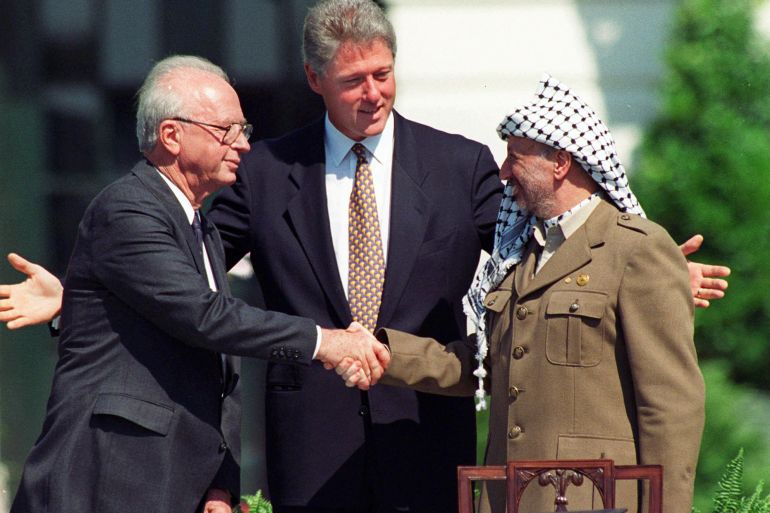
Thirty years ago, Israeli and Palestinian leaders met on the lawn of the White House in Washington to sign a deal many believed could be a precursor for peace in the region.
The first Oslo Accord brought together Yitzhak Rabin and Yasser Arafat. The former was the Israeli prime minister, and the latter was the leader of the Palestine Liberation Organization (PLO).
Keep reading
list of 4 items‘War crime’: Israel forcibly transfers Palestinian village
‘Arm us or protect us’: PA’s role questioned amid settler attacks
Is BRICS really the lifeline Palestine needs?
A handshake was to follow between them – a significant gesture and the deal would lead them to both receive the Nobel Peace Prize, along with then-Israeli Foreign Minister Shimon Peres, the following year.
All three men are now dead, Rabin in circumstances directly related to the Accords. The peace process that the deal was supposed to begin has been stillborn, with Israel continuing its illegal occupation of Palestinian territory, and the Palestinian people no closer to – and some would argue further away from – an independent state.
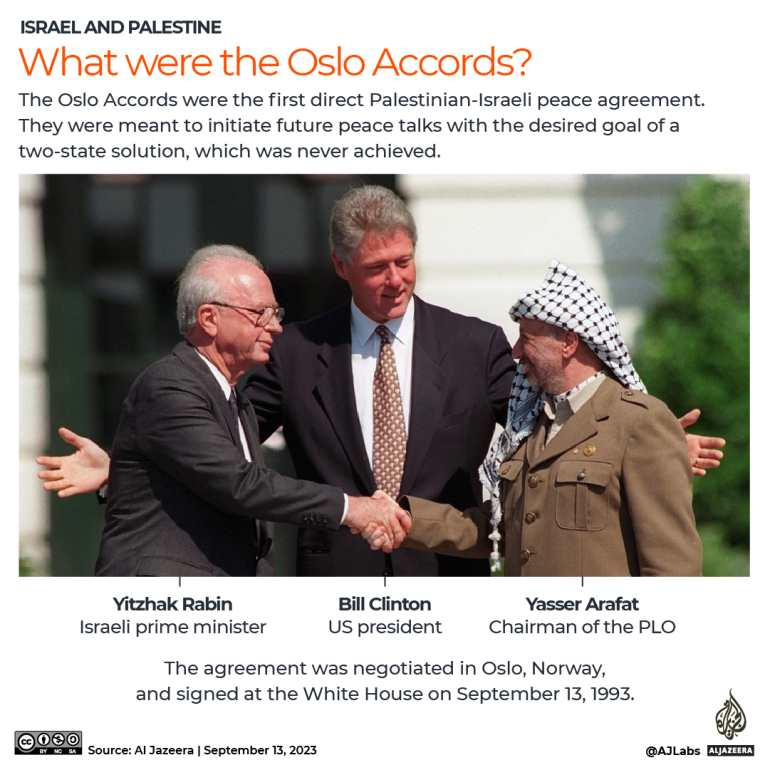
Here’s everything you need to know about the historic agreement and why it has seemingly failed:
What were the Oslo Accords?
The first Oslo Accord, known as Oslo I, was signed on September 13, 1993. The agreement between the Israeli and Palestinian leadership saw each side recognise the other for the first time. Both sides also pledged to end their decades-long conflict.
A second accord, known as Oslo II, was signed in September 1995 and went into more detail on the structure of the bodies that the peace process was supposed to form.
The Oslo Accords were supposed to bring about Palestinian self-determination, in the form of a Palestinian state alongside Israel. This would mean that Israel, which was formed on the land of historic Palestine in 1948 in an event Palestinians know as the Nakba, would accept Palestinian claims to national sovereignty. The claims, however, would only be limited to a fraction of historic Palestine, with the rest left to Israel’s sovereignty.
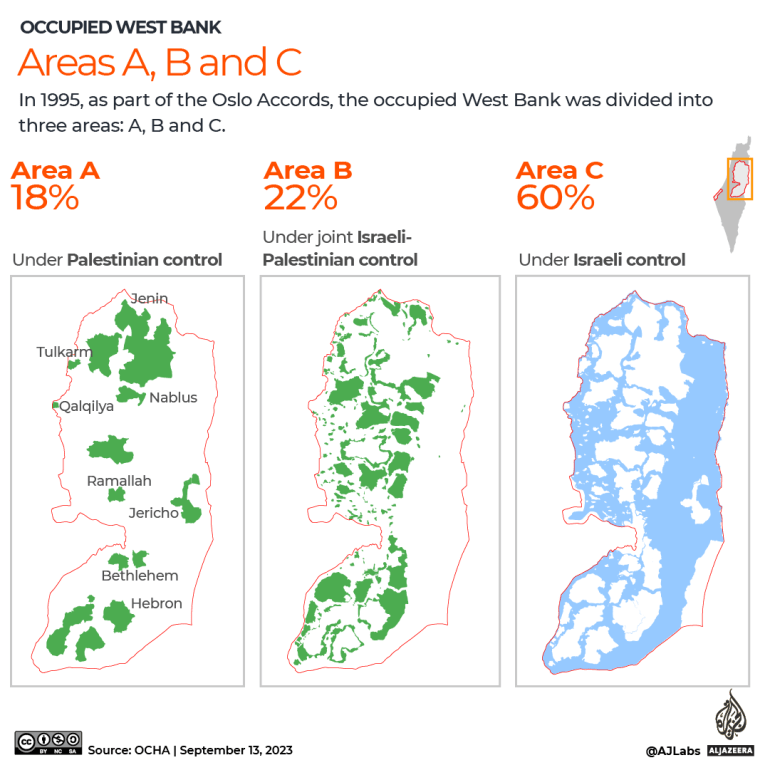
To meet that goal several steps would need to be taken, including the phased withdrawal of the Israeli military from the Palestinian territories it had illegally occupied since 1967, and the transfer of authority to a Palestinian administration, except for final status issues, including the status of Jerusalem (the eastern half of which is occupied Palestinian land) and Israel’s illegal settlements, which would be negotiated at a later date.
The accords therefore led to the creation of the supposedly temporary Palestinian Authority (PA), and the division of territory in the West Bank into Areas A, B and C, denoting how much control the PA has in each. which to this day administers limited rule over the two areas.
A final treaty was to be reached in five years – but that has not happened.
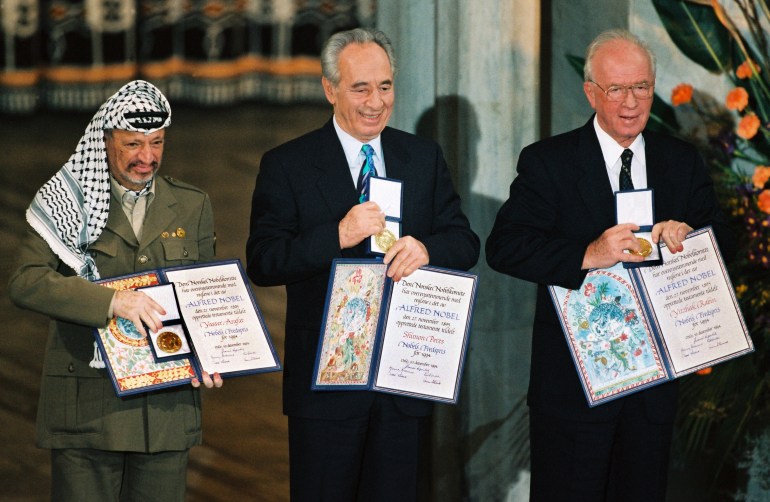
Who was opposed to the deal?
Right-wing Israelis had no desire to give the Palestinians any concessions, and did not want any agreements with the PLO, which they considered a “terrorist organisation”. Israeli settlers also feared it would lead to their eviction from the illegal settlements in the occupied territories.
Elements of the far-right were so opposed to the Oslo Accords that Rabin himself was assassinated in 1995 for signing them. Among the people who had threatened Rabin before his death was Itamar Ben-Gvir, now Israel’s National Security Minister.
Meanwhile, Palestinian groups, including Hamas and Islamic Jihad, warned that a two-state solution would forgo the right of Palestinian refugees to return to the historic lands seized from them in 1948 when Israel was created.
The late prominent Palestinian literary critic and activist Edward Said was among its most vocal critics, calling it “an instrument of Palestinian surrender, a Palestinian Versailles”.
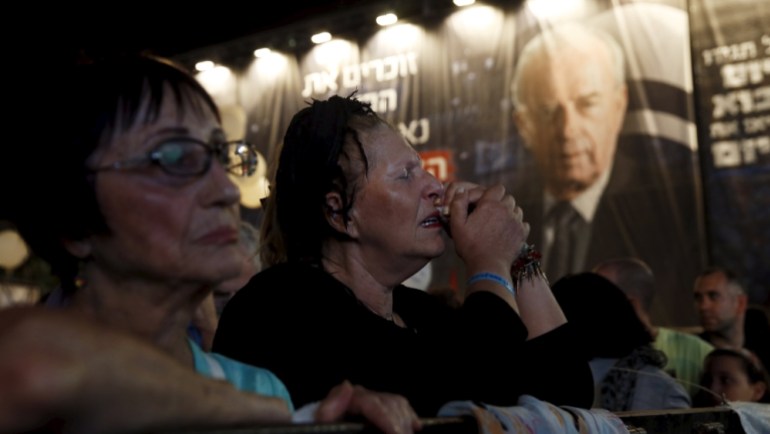
How did the accords break down?
The Oslo Accords witnessed a slow decline, with Israel continuing its occupation of Palestinian land and refusing to withdraw militarily from the majority of the West Bank while continuing to conduct raids into land considered under the full administration of the PA.
Following Rabin’s death, a number of Israeli leaders who opposed the accords came to power, among them current Israeli Prime Minister Benjamin Netanyahu as well as Ariel Sharon.
A second intifada from 2000 to 2005 in turn led to heavy casualties, particularly on the Palestinian side, and made both sides less willing to agree to move the deal along.
Any attempt at restarting talks failed in the decade after, and the accords’ interim clauses have become the status quo.
How are the accords viewed now?
Many Palestinians believe that Israel has used the Oslo Accords to justify its expansion of illegal settlements in the West Bank.
In fact, as the Oslo Accords slowly broke down, Israel tripled its settlement building. Between 1993 and 2000, the Israeli population in the West Bank reached its fastest pace of growth ever, according to Dror Etkes, an Israeli peace campaigner.
Today, the Israeli government is dominated by far-right religious and ultranationalist politicians who have close ties to the settlement movement. In recent months, they have approved thousands of new homes in settlements in the occupied West Bank.
In fact, according to the left-wing Israeli movement Peace Now, Israel this year set a record for its settlement approvals, with at least 12,855 settler housing units approved since January.
Thirty years on, Palestinian statehood is unlikely in the short and even medium term, as final-status negotiations between Palestinian and Israeli leaders have continuously failed.
The West Bank lies fragmented, the blockaded Gaza Strip stands isolated in what many call an “open-air prison”, and Israel has no plans to relinquish occupied East Jerusalem.
Many people, in both Israel and Palestine, believe the two-state solution is dead.